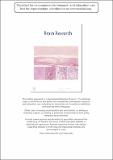| dc.contributor.author | Hogan, Michael. J. | |
| dc.contributor.author | Kilmartin, L. | |
| dc.contributor.author | Keane, M. | |
| dc.contributor.author | Collins, P. | |
| dc.date.accessioned | 2013-10-21T10:25:22Z | |
| dc.date.available | 2013-10-21T10:25:22Z | |
| dc.date.issued | 2012-03-22 | |
| dc.identifier.citation | Hogan, M.J.; Kilmartin, L.; Keane, M.; Collins, P.; Staff, R.; Kaiser, J.; Lai, R.; Upton, N. (2012) 'Electrophysiological entropy in younger adults, older controls and older cognitively declined adults'. Brain Research, (1445):1-10. | en_US |
| dc.identifier.issn | 0006-8993 | |
| dc.identifier.uri | http://hdl.handle.net/10379/3764 | |
| dc.description | Journal article | en_US |
| dc.description.abstract | The current study examined electrophysiological entropy in younger adults, older adults, and older cognitively declined adults across four experimental conditions - eyes closed, eyes open, and during both encoding and recognition of words in a memory task. We hypothesised reduced entropy in older declined adults relative to both older controls and younger adults, with the largest group differences in entropy expected during the encoding and recognition phases of the experiment. We also hypothesised greater hemispheric asymmetry in younger adults compared with older controls and older declined adults. Results revealed significant increases in entropy from eyes closed to eyes open to task. Young adults showed higher entropy in the right relative to the left hemisphere in the temporal lobe and higher entropy in the left relative to the right hemisphere in the parietal lobe. Old cognitively declined adults showed no significant differences between right and left hemisphere entropy. There was a trend whereby older declined adults showed lower entropy than older controls in the frontal lobe, this difference being largest in the left hemisphere during the encoding phase of the experiment. Results indicate that measures of entropy are sensitive to information processing demands and that higher cognitive performance may not be a simple function of entropy level, but rather a combination of level and range, or differentiated range of entropy states across the brain. | en_US |
| dc.format | application/pdf | en_US |
| dc.language.iso | en | en_US |
| dc.publisher | Elsevier | en_US |
| dc.relation.ispartof | Brain Research | en |
| dc.rights | Attribution-NonCommercial-NoDerivs 3.0 Ireland | |
| dc.rights.uri | https://creativecommons.org/licenses/by-nc-nd/3.0/ie/ | |
| dc.subject | Ageing | en_US |
| dc.subject | Memory | en_US |
| dc.subject | EEG | en_US |
| dc.subject | Entropy | en_US |
| dc.title | Electrophysiological entropy in younger adults, older controls and older cognitively declined adults. | en_US |
| dc.type | Article | en_US |
| dc.date.updated | 2013-10-02T11:03:38Z | |
| dc.local.publishedsource | http://dx.doi.org/10.1016/j.brainres.2012.01.027 | en_US |
| dc.description.peer-reviewed | non-peer-reviewed | |
| dc.contributor.funder | |~| | |
| dc.internal.rssid | 3136167 | |
| dc.local.contact | Michael Hogan, Dept. Of Psychology, Room 202, St. Anthony'S, Nui Galway. 3455 Email: michael.hogan@nuigalway.ie | |
| dc.local.copyrightchecked | No | |
| dc.local.version | ACCEPTED | |
| nui.item.downloads | 653 | |


